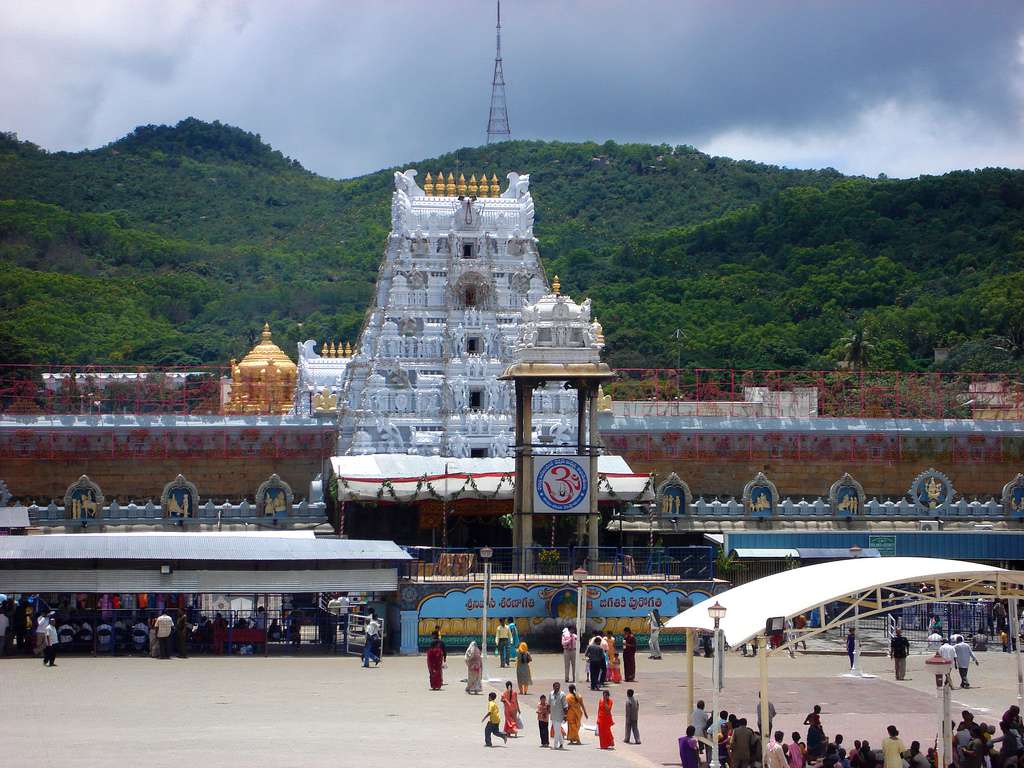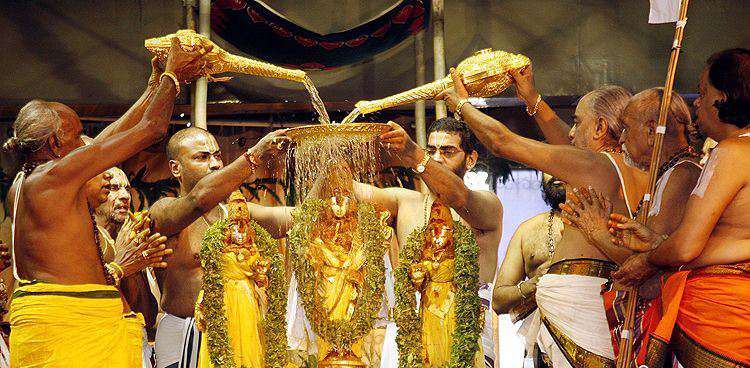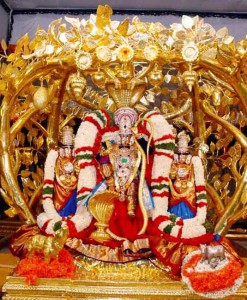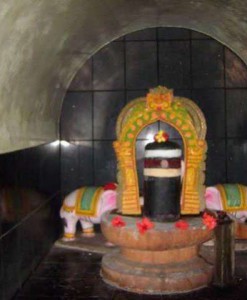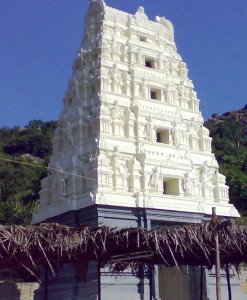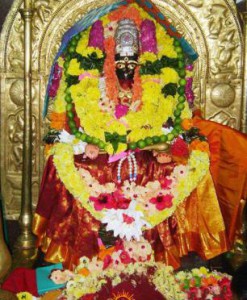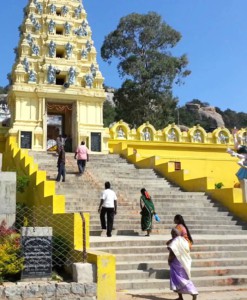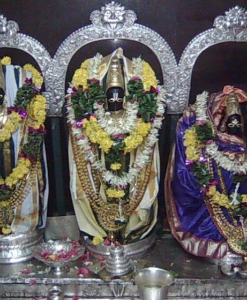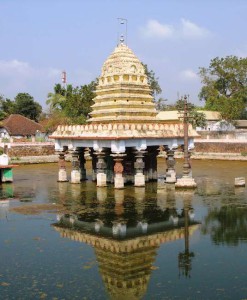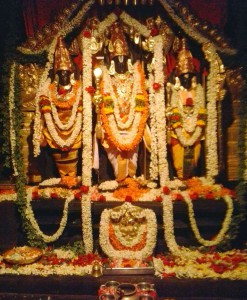No products in the cart.
Tirupati Balaji Temple is a famous Vedic temple in the hill town of Tirumala, near Tirupati in Chittoor district of Andhra Pradesh. It is the richest temple in the world in terms of donations received and wealth, and the most-visited place of worship in the world. The temple is visited by about 50,000 to 100,000 pilgrims daily (30 to 40 million people annually on average), while on special occasions and festivals, like the annual Brahmotsavam, the number of pilgrims shoots up to 500,000, making it the most-visited holy place in the world.
Tirumala Tirupati Balaji Temple is positioned on Venkatachala or Ventaka Hill (the seventh peak of the Tirupati Hill) in Chittoor district, Tirupati Temple. Dedicated to Sri Venketeshwara, the temple lies on the southern side of Swami Pushkarini.
Lord Balaji is also famous as Govinda. Lord Balaji is very kind and helps anyone who prays to Him for help. Lord Balaji at Tirupati has performed numerable miracles. The Lord Balaji is famous as the Lord helps during one’s misfortune. Venkateshwara means the Lord, who frees us from all of our sins. Ven means sin, Kat means one who delivers. We remain in this world, suffering, birth after birth, because of our sinful reactions, now in this age of kali, it is an age of sin. It is an ocean of faults.
The names ascribed to the main deity are Balaji, Srinivasa, Venkateswara, Edukondalavadu (Lord of seven hills in Telugu), “Aapadhamrokkuluvaadu” (Saviour of devotees during calamities in Telugu), Venkatachalapathy’ ‘or Venkataramana in Telugu, Malayappa (Father of hill in Tamil), Elumalaiyaan (Lord of seven hills in Tamil). The goddess Sri or Lakshmi (Vishnu’s consort) resides on the chest of Venkateswara; thus, he is also known by the epithet “Srinivasa” (the one in whom Sri resides). The goddesses Lakshmi and Padmavathi reside on either side of his chest. The deity is considered the Kali yuga varada, that is, ‘the boon-granting Lord of Kali yuga’. (Kali yuga is the fourth and final age of the Hindu cycle of ages). The temple is held in particular reverence by the sect who hails from “Naimisharanya” (north India), known as the Sri Vaikhanasa/ Adhi Vaikhanasas followers of Sri Vikanasa Muni.
Tirupati Balaji Temple, Andhra Pradesh
Medieval history
The deity itself is self-formed or swayambhu. Thondaiman, ruler of the ancient Thondaimandalam (present day Kanchipuram) is believed to have first built the temple after visualizing Lord Vishnu in his dream. He built the Gopuram and the Prakhara, and arranged for regular prayers to be conducted in the temple. Later on the Chola dynasty vastly improved the temple and gave rich endowments. To date, you will find the various Tamil Grantha script within the Temple prakara walls. The Sangam literature of Tamil such as that of Silapadikaram and Satanar Manimekalai, dated between 500BC and 300AD, mentions Thiruvengadam (now named Tirupati) by the appellation “Nediyon Kunram” as the northernmost frontier of the Tamil kingdoms. In fact, a fairly detailed description of the deity is given in lines 41 to 51 of book 11 of the Silapadikaram. Pallavas king of Thondaimandalam alias Tondai Nadu in Tamilnadu Raja Karunakara Thondaiman (Thondaiman Chakravarty) chiefly contributed to building the temple. Krishnadevaraya is also said to have made several endowments to the temple. The Pallavas of Kanchipuram (9th century AD), the Cholas of Tanjore (10th century), and Vijayanagara pradhans (14th and 15th centuries) were committed devotees of Lord Venkateswara. During the invasion of Srirangam by Malik Kafur in 1310–11 AD, the Ranga Mandapam of the temple served as the shelter for the presiding deity of Srirangam, Ranganatha Swamy. Later, under the rule of the Vijayanagara emperors, was when the temple gained most of its current wealth and size, with the donation of diamonds and gold. In 1517 Vijayanagara ruler Sri Krishna Deva Raya, on one of his many visits to the temple, donated gold and jewels, enabling the Vimana (inner shrine) roofing to be gilded. Statues of Sri Krishna Deva Raya and his spouse stand in the premises of the temple. After the decline of Vijayanagara Empire, kings from states such as Mysore and Gadwal worshiped as pilgrims and gave ornaments and valuables to the temple. Maratha general Raghoji I Bhonsle (died 1755) visited the temple and set up a permanent administration for the conduct of worship in the temple. There is an idol of Raja Todar Mal who was the revenue minister of Akbar, greeting pilgrims in the premises of the temple.
Modern history
In 1843, with the coming of the Madras Presidency, the administration of the Sri Venkateswara Temple and a number of shrines was entrusted to Seva Dossji of the Hathiramji Mutt at Tirumala as Vicaranakarta for nearly a century until the Tirumala Tirupati Devasthanams (TTD) was established as a result of the TTD Act in 1932.
After independence Andhra state was created on linguistic grounds, where in Tirupati which had and still has a majority of Telugu speaking population was assigned by Govt. of India, integrating it as part of Andhra.
Temple today
TTD is operated by a Board of Trustees that has increased in size from five (1951) to fifteen (1987) through the adoption of Acts. The daily operation and management of TTD is the responsibility of an executive officer who is appointed by the government of Andhra Pradesh.
The temple attracts approximately 75,000 pilgrims every day. The annual budget, estimated at INR 10 billion in 2008, runs charitable trusts whose funds are derived from the budget and donations from the devotees. The popularity of the temple can be judged by its annual budget. The annual income is estimated at INR 10 billion in 2008. Most of its income is derived from the donations in SriVari Hundi. Devotees donate to the TTD, which runs into millions of rupees. TTD, the organisation running the welfare of the temple, runs various charitable trusts, whose funds are derived from the budget and donations from the devotees.
This ancient temple is supposed to have been standing since ages. Comprised of ‘Gopuram’ (tower), the temple is a fine example of Dravidian style of architecture. There is a gilded cupola (Vimana) by the mane of “the Ananda Nilayam” over the main shrine. The shrine comprises three enclosures, which are also known as ‘Prakarams’. The outmost enclosure comprises the ‘Dhvajastambha’ (banner post) and the other enclosures have many statues including statues of King Krishnadevraya and Todarmal (minister of Akbar). The striking idol of Sri Venkateswara / Balaji lies in the main sanctum sanctorum of the temple.
Moolavirat or Dhruva Beram — The main stone deity of Lord Venkateswara is called Dhruva Beram (beram means “deity”, and dhruva means “pole star” or “fixed”). The deity is about 8 feet (2.4 m) from the toes to the top of the crown and is considered the main source of energy for the temple.
Kautuka Beram or Bhoga Srinivasa — This is a tiny one-foot (0.3 m) silver deity, which was given to the temple in 614 AD by Pallava Queen Samavai Perindevi, and has never been removed from the temple from the day it was installed. This deity is popularly known as Bhoga Srinivasa, because it enjoys all the Bhoga (worldly pleasures) which the Moolavirat has. This deity sleeps in a golden cot every night and receives Sahasra Kalashabishekam every Wednesday. This deity is always placed near the left foot of Moolavirat and is always connected to the main deity by a holy Sambandha Kroocha. The deity is always faced at an angle of 45 degrees towards the devotees, because it holds a Prayoga (“ready to strike”) Chakra.
Snapana Beram or Ugra Srinivasa — This idol of the Lord represents the anger part of Lord Venkateswara. He remains inside the sanctum sanctorum, and comes out on only one day each year: on Kaishika Dwadasi, before the sunrise. Snapana means “cleansing”. The idol is cleansed daily with holy waters, milk, curds, ghee, sandalwood paste, turmeric, and so on.
Utsava Beram — This is the form of the Lord which comes out of the temple to see the devotees. This deity is also called Malayappa, and its consorts are Sridevi and Bhudevi. These three deities were found in a cave called Malayappan Konai in the holy Tirumala Hills. Originally Ugra Srinivasa was the Utsava Beram (the procession deity), and frequently disastrous fires were happening whenever the deity was taken out for processions. People prayed to the Lord for a solution. The Lord appeared in dreams, and ordered the people to find a suitable set of idols hidden in the Holy Tirumala hills for the Utsavar (procession). The hunt began, and the villagers called the idol they found Malayappa, which means “King of the Hills”. After these idols were brought to the temple, the number of programmes increased to include Nitya Kalyanaotsavam, Sahasra Deepalankara Seva, Arjita Brahmotsavam, Nityaotsvam, Dolotsavam, and others. Jewels worth millions of rupees have been donated as offerings to these idols.
Bali Beram or Koluvu Srinivasa — This panchaloha idol resembles the main deity, and represents the presiding officer for all activities and rituals in the temple. The idol is also called Bali Beram. Koluvu Srinivasa is regarded as the guardian deity of the temple that presides over its financial and economic affairs. Daily offerings are made to the deity, with a presentation of accounts. Every year during July i.e. according to Hindu calendar “Dakshinaya Sankaramana” the temple celebrates “Anivar Asthanam” which is the end of the fiscal year.
Vimanam
The vimanam is a monumental tower with a golden roof. Its inner temple or vimanam houses the main deity, Lord Sri Venkateswara. The deity stands directly beneath a gilt dome called the Ananda Nilaya Divya Vimana. This exquisitely wrought deity, called the Mulaberam, is believed to be self-manifested, and no human being is known to have installed it in the shrine. The Lord wears a gold crown with a large emerald embedded in the front. On special occasions, he is adorned with a diamond crown. The Lord has a thick double tilaka drawn on his forehead, which screens his eyes. His ears are decorated with golden earrings. The right hand is pointing to his lotus feet. His left hand is akimbo. His body is dressed with yellow clothing tied with gold string and a gold belt with gold bells. He has a yajnopavita (sacred thread) flowing down crosswise from his left shoulder. He bears Lakshmi Devi on his right chest and Padmavathi Devi on his left chest. His feet are covered with gold frames and decked with gold anklets. A curved gold belt encompasses his legs. The Ananda Nilaya Divya Vimana was covered with gilt copper plates and surmounted with a golden vase in the 13th century, during the reign of the Vijayanagara king Yadava Raya.
Bangaru Vakili
From the Tirumamani Mandapam, one can enter the Bangaru Vakili (Meaning Golden Entrance in Telugu) to reach the inner sanctum sanctorum. There are two tall copper images of the dwarapalakas Jaya and Vijaya on either side of the door. The thick wooden door is covered with gilt plates depicting the dasavataram of Sri Maha Vishnu. The doorway is directly in line with the Padi Kavali and the Vendi Vakili (Meaning Silver Corridor in Telugu). It admits pilgrims to the Snapana Mandapam. Suprabhatam is sung in front of this door.
Garbha Gruham
The Garbhagruha or sanctum is where the idol of Lord Sri Venkateswara is placed. The idol stands majestically in the Garbha Gruha, directly beneath a gilt-dome called the “Ananda Nilaya Divya Vimana”. This idol, called the Mulaberam, is believed to be self-manifested. As there is no known sculptor possessing the capability to sculpt idols of god so proportionately. Further, no human being is known to have installed it in the shrine.
Tirupati is another name of festivities, so with each new day, there comes a festival. Every day, fair of pilgrims at the shrine add to the festivity of this temple. The town celebrates most Vaishnava festivals, including Vaikuntha Ekadasi, Rama Navami, and Janmashtami with great splendor, while the Brahmotsavam celebrated every year during September is the most important festival in Tirumala. The temple receives millions of devotees over the short span of a week. The most famous is the annual festival called ‘Brahmotsavam’, which is celebrated on grand scale for nine days in September, attracting pilgrims and tourists from all parts of the country. The fifth and ninth days of the festival are especially significant in as much as Garudostavam and Rathotavam takes place on those days.
Other major festivals include Vasanthotsavam (spring festival), conducted in March–April and Rathasapthami (Magha Shuddha Saptami) and celebrated in February, when Lord Venkateswara’s deity is taken on procession around the temple chariots.
Special Rituals/ Prarthana performed in temple
Lord Vishnu is worshiped in the Temple as per Vaikhanasa traditions. The ancient texts of the sage Marichi (the Bhagvad Shastram and Vimanarchana Kalpam) state that Lord Vishnu here should be worshipped six times a day.
UshaKala Aradhana — worship (or Aradhana) should start and finish before sunrise
Prathakala Aradhana — worship should start after sunrise and finish before noon
Madhyanika Aradhana — worship should start and finish at noon
Aparahana Aradhana — worship should start when the sun starts to descend
SandhyaKala Aradhana — worship should start and finish around the sunset
Ardharatri Aradhana — worship should start after the horizon is completely dark
All the Aradhana is done by hereditary Vaikhanasa priests, who have performed the services for generations. Only these priests have the right to touch and offer services to the Lord. These set of Archakas are called Mirasidars (owners and shareholders of the temple). The four families of the Tirumala Temple which are in this Mirasi are the Gollapalli, Peddintti, Paidipalli, and Tirupathammagari family.
For worshippers, the deity Venkateswara symbolises goodness. When people travel to Tirupati Balaji Temple, they chant the mantra Ezhumalayanukku Govinda Govinda or Venkataramana Govinda (in Tamil), Yedukondalavada Venkataramana Govinda Govinda (in Telugu) or Om Namo Narayanaaya or Om Sri Venkatesaya Namah (in Sanskrit). Lord Venkateswara is believed by followers to be a very merciful form of Vishnu, being the fulfiller of every wish made to him by the devotees.
Temple Pooja Daily Schedule
Every day, morning 6.00 am, the Lord is woken up, while reciting the Venkateshwara Suprabhatam and then the shodasha upacharam is performed. While waking up the Lord, 108 names of Lord are chanted along with offering of flowers and Tulsi at the lotus feet of Lord and Archana is performed.
Then the Lord is bathed and fresh silk clothes and jewellaries along with camphor, chandan are offered to the Lord. Lord is then dressed. Then fresh garlands are offered to the Lord, which are made by devotees following devotional standards.
Dhupa, deepa, Fruits and milk sweets are offered in the balabhogam at 7.30am. At noon 12.00pm, Rajabhoga – delicious dishes are offered to the Lord. In the evening at 6.00 pm Sandhya Bhog which includes fruits are offered.
In Ekanta Seva, Lord is put to rest while massaging the feet with the recitation of devotional prayers and songs
Prasadam
The world famous Tirupati Laddu is given at the Tirupati Balaji Temple as prasadam. Recently, the Trust has taken Geographical Indication of Laddu prasadam, hence, no one can prepare the same Laddu. Many other prasadams are also available including daddojanam (curd rice), pulioharey (tamarind rice), vada and chakkera-pongali (sweet pongal), miryala-pongali, Appam, Paayasam, Jilebi, Muruku, Dosa, seera (kesari). Free meals are given daily to the pilgrims. On Thursdays, the Tirupavadai seva is conducted, where food items are kept as naivedyam to Lord Srinivasa..
Hair Tonsuring
Devotees shaving their heads at Tirumala Venkateswara Temple. Many devotees have their head tonsured as “Mokku”, an offering to God. The daily amount of hair collected is over a ton. The hair thus gathered is sold by the temple organisation a few times a year by public auction to international buyers for use as hair extensions and in cosmetics,[29] bringing over $6 million to the temple’s treasury. This is the second highest income generating activity in the temple next to the Hundi Collection.
When Lord Balaji was hit on his head by a shepherd, a small portion of his scalp became bald. This was noticed by Neela Devi, a Gandharva princess. She felt “such an attractive face should not have a flaw”. Immediately, she cut a portion of her hair and, with her magical power, implanted it on his scalp. Lord Balaji noticed her sacrifice. As hair is a beautiful asset of the female form, he promised her that all his devotees who come to his abode would offer their hair to him, and she would be the recipient of all the hair received. Hence, it is believed that hair offered by the devotees is accepted by Neela Devi. The hill, Neeladri, one of the seven hills, is named after her.
Hundi (donation pot)
It is believed that Srinivasa had to make arrangements for his wedding. Lord Kubera credited money to the god Venkateswara (a form of the god Vishnu) for his marriage with Padmavati. Srinivasa sought a loan of one crore and 11.4 million (11,400,000) coins of gold from Kubera and had Viswakarma, the divine architect, create heavenly surroundings in the Seshadri hills. Together, Srinivasa and Padmavathy lived for all eternity while Goddess Lakshmi, understanding the commitments of Lord Vishnu, chose to live in his heart forever. In remembrance of this, devotees go to Tirupati Balaji Temple to donate money in Venkateswara’s hundi (donation pot) so that he can pay it back to Kubera. The hundi collections go as high as 22.5 million INR a day. Devotees offer gold as a token of their love for God. Temple sources said that in April 2010 the temple deposited 3,000 kg of gold with SBI as gold offerings in the temple hundi by devotees, which had accumulated for the last several years.
Thulabharam
One of the most important offering in this temple is the ‘thulabharam.’ In the Thulabaram ritual, a devotee sits on a pan of a weighing balance and the other pan is filled with materials greater than the weight of the devotee. Devotees usually offer sugar, jaggery, tulsi leaves, banana, gold, coins. This is mostly performed with newborn babies or children.
Arjitha seva (paid services)
Pilgrims can view and participate (in a limited fashion) in the various sevas performed to Dhruva bera (main idol), Bhoga Srinivasa, Sri Malayappa swami and other idols in the temple.
When pilgrims purchase arjitha seva tickets, they get the opportunity to see a seva performed to the Lord, obtain prasadam in the form of vastram (clothes), akshantalu (sacred and blessed rice) and food articles (laddus, vadas, dosas, pongal, rice items) and a darshan of the utsava murti.
Tarapith is a temple town in Birbhum. It is a major Hindu pilgrimage centre and several thousand devotees visit the temple every day.
Tarapith is at a distance of 264 km from Kolkata, 96 km from Santiniketan, 116 km from Durgapur, 150 km from Deoghar and 205 km from Mayapur.
If you want to make a travel to this place you can choose any of the following options:
By Bus
Tirupati is linked with important cities like Hyderabad, Bangalore, Chennai,, Vijayawada, and Lepakshi through good roadways.
By Air
Tirupati owns an airport which is located at Renigunta, which is 15 km from the main city. Regular and direct flights from Hyderabad, Chennai and Bangalore to Tirupati are available. If travelling internationally, the nearest international airport is located at Chennai.
By Train
Tirupati railway station is connected to the major metro cities like Mumbai, Bangalore, Chennai, Vishakhapatnam, Delhi, Madurai and Hyderabad. Tourists coming from other places can reach Renigunta, which is at a distance of 15 km from the main city.

